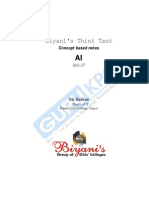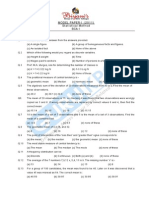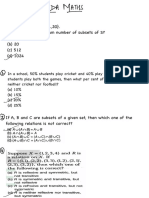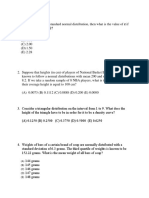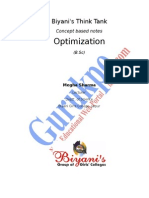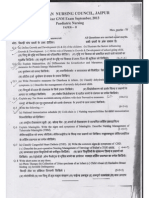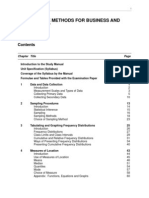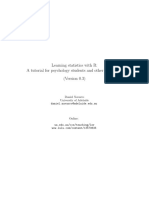90%(10)90% found this document useful (10 votes)
10K viewsStatistical Methods MCQ'S
Statistical Methods MCQ'S
Uploaded by
GuruKPOThe document contains multiple choice questions related to statistics, probability, and sampling. It covers topics like analysis of variance, expected value, sample space, probability definitions, random sampling, stratified sampling, and sampling errors. The questions are divided into four sets and assess concepts like degrees of freedom, correction factors, sample size impacts, and distinguishing properties of different sampling techniques.
Copyright:
© All Rights Reserved
Statistical Methods MCQ'S
Statistical Methods MCQ'S
Uploaded by
GuruKPO90%(10)90% found this document useful (10 votes)
10K views41 pagesThe document contains multiple choice questions related to statistics, probability, and sampling. It covers topics like analysis of variance, expected value, sample space, probability definitions, random sampling, stratified sampling, and sampling errors. The questions are divided into four sets and assess concepts like degrees of freedom, correction factors, sample size impacts, and distinguishing properties of different sampling techniques.
Original Description:
Statistical Methods
Copyright
© © All Rights Reserved
Share this document
Did you find this document useful?
Is this content inappropriate?
The document contains multiple choice questions related to statistics, probability, and sampling. It covers topics like analysis of variance, expected value, sample space, probability definitions, random sampling, stratified sampling, and sampling errors. The questions are divided into four sets and assess concepts like degrees of freedom, correction factors, sample size impacts, and distinguishing properties of different sampling techniques.
Copyright:
© All Rights Reserved
90%(10)90% found this document useful (10 votes)
10K views41 pagesStatistical Methods MCQ'S
Statistical Methods MCQ'S
Uploaded by
GuruKPOThe document contains multiple choice questions related to statistics, probability, and sampling. It covers topics like analysis of variance, expected value, sample space, probability definitions, random sampling, stratified sampling, and sampling errors. The questions are divided into four sets and assess concepts like degrees of freedom, correction factors, sample size impacts, and distinguishing properties of different sampling techniques.
Copyright:
© All Rights Reserved
You are on page 1of 41
Set-1
Q. If the value of T2 is 1600 and N=16 then the value of C.F.is
(a) 100
(b) 200
(c) 102
(d) 105
Q. When the source of variance is between the rows the degree of
freedom is:
(a) C-1
(b) r-1
(c) (C-1)(r-1)
(d) N-1
Q. If the value of T2=0 , value of N=12 then the value of C.F. is
(a) 15
(b) 12
(c) 0
(d) 1
Q. The value of F is mostly obtained according to level of
significance
(a) 5 or 1%
(b) 7 or 8 %
(c) 6 or 4 %
(d) 2 or 3%
Q. The technique of analysis of variance was first originated by :
(a) Fisher
(b) davies
(c) Connor
(d) Spearmean
Q. When the source of variance is between the samples what the
degree of freedom is.
(a) k-1
(b) N-K
(c) N-1
(d) N2-1
Q. The formula of calculating correction factor is
(a)
(b)
(c)
(d)
Q. When 2 data are compared for particle purpose there, Difference
stated through the technique in called
(a) Variance
(b) Analysis of variance
(c) Decision theory
(d) Business forecasting
.
Set-2
Q. Two tickets are taken at random from 5 tickets number 1 to 5.
The expected value of the sum obtained on the two tickets is :
(a) 5
(b) 3
(c) 6
(d) 7
Q. A player tosses 3 fair coins , He wins Rs. 5 if 3 heads appear, Rs.
3 if 2 heads appear, Re. 1 if 1 head appears. On the other hand he
losses Rs. 15 if 3 tails appear. His expected gain (in rupees ) is :
(a) 0.15
(b) 0.25
(c) -0.25
(d) -0.15
Q. There are 100 tickets in a lottery o Re. 1 each. There is only one
ticket in the lottery bearing a prize of Rs.80. A person purchased
on e ticket. Hits expectation is :
(a) -0.20
(b) -0.80
(c) 0.20
(d) 0.80
Q. There are 5 tickets in a box numbered 1, 1,2,2,2 respectively.
Two tickets are taken at random from it, then the expectation of
the total of the numbers on the tickets is :
(a) 11/5
(b) 13/5
(c) 16/5
(d) 7/5
Q. There are 3 black balls and 2 white balls in a box. 2 balls are
taken from it. Rs.24 is given for each black ball. What amount (in
rupees) should be charged for each white ball so that the game is
fair.
(a) 26
(b) 36
(c) 16
(d) 46
Q. There are 5 white and 3 black bulbs in a box. 3 bulbs are taken
at random from the box. The expected number of black balls is :
(a) 7/8
(b) 9/8
(c) 11/8
(d) 5/8
Q. Two coins are tossed simultaneously. A person receives Rs.8 for
each head and looses Rs.10 for each tail. The expected value of the
amount gained by him (in rupees) in
(a) 2
(b) -2
(c) 3
(d) -4
Q. There are 10 electric bulbs in a box in which 3 are defective
bulbs. If 3 bulbs are selected at random from the box, then the
expected number of defective bulbs is :
(a) 0.7
(b) 0.9
(c) 0.6
(d) 0.5
Q. There are 2 white and 4 black balls in a box. A person takes 3
balls at random from the box. If he receives Rs.10 for each white
ball and receive Rs.5 for each black ball, then the expected value of
the amount received by him (in rupees) is :
(a) 20
(b) 30
(c) 15
(d) 25
Q. There are two coins. On one face of each coin 1 is written and
on the other face 24 written. Two coins are tossed simultaneously.
The expected value of the total on the coins is:
(a) 4
(b) 2
(c) 3
(d) 7
Q. If one of the outcomes cannot be expected to occur in
preference to the other in an experiment the events are :
(a) Compound events
(b) simple events
(c) favorable events
(d) equally likely events
Q. Probability mass function is always:
(a) 0
(b) greater than 0
(c) Greater than equal to 0
(d) equally likely
Q. According to the statistical definition of probability, the
probability of an event A is the
(a) Limiting value of the ratio of the number of times the event A occurs
to the number of times the experiment is repaired
(b) The ratio of the frequency of the occurrences of A to the non-
occurrence of A
(c) The ratio of the frequency of the occurrences of A to the total
frequency
(d) The ratio of the favorable elementary events to A to the total number
of elementary events.
Q. When a dice is tossed, the sample space is :
(a) S=(1,2,3,4,5)
(b) S=(1,2,3,4)
(c) S=(1,2,3,4,5,6)
(d) S=None of these
Q. Two broad divisions of probability are :
(a) Subjective probability and objective probability
(b) Statistical probability and Mathematical probability
(c) Deductive probability and non-deductive probability
(d) None of these
Q. The classical definition of probability is based on the feasibility
at subdividing the possible outcome of the experiments into :
(a) Exhaustive and equally likely cases
(b) Mutually exclusive and exhaustive cases
(c) Mutually exclusive and exhaustive cases
(d) mutually exclusive, exhaustive and equally likely cases.
Q. The limitations of the classical definition of probability is that:
(a) It is applicable if the if the elementary events are equally likely
(b) It is applicable when the total number of elementary events is finite
(c) It is applicable if the elementary events are mutually independent
(d) Both (a) or (b)
Q. The terms chance and probability are synonymous.
(a) True
(b) False
(c) Both
(d) None of the above
Q. All possible outcomes of a random experiment form the
(a) Sample space
(b) events
(c) both
(d) none of the above
Q. Initially , probability was a branch of
(a) Mathematics
(b) Statistics
(c) Physics
(d) Economics
Set-3
Q. Which of the following statements does not hold good in case of
stratified sampling?
(a) Stratified sampling is always good
(b) Stratified sampling is convenient.
(c) Reduces error for fixed cost
(d) enables to gather information about different stratum separately.
Q. An estimate based on a fixed set of values of a sample always
posses:
(a) a single value
(b) any value
(c) a value equal to one
(d) all of these
Q. The magnitude of the standard error of an estimate is an index
of its:
(a) Accuracy
(b) precision
(c) efficiency
(d) all of these
Q. In random sampling, we can describe mathematically how
objective our estimates are. Why is this?
(a) We always know the chance that a
(b) Every sample always has an equal chance of being Population element
will be included in the
(c) (a) and (b) but not (c) Sample
(d) All the samples are of exactly the same size and can be counted
Q. Regarding the number of strata, which statement is true?
(a) More the number of strata, poorer it is.
(b) Lesser the number of strata, better it is
(c) More the number of strata, better it is
(d) Not more than ten items should be there in a stratum.
Q. Non-response in surveys mean:
(a) Non-return of questionnaire by the respondents
(b) Non-availability of respondents.
(c) Refusal to give information by the respondents
(d) all of the above
Q. Which of the following basis distinguishes cluster sampling
from stratified sampling?
(a) A sample is always drawn from each stratum
(b) Clusters are preferably heterogeneous whereas strata Where as no
sample of elementary units is are taken as homogeneous as possible
drawn from cluster
(c) all of the above
(d) Small size clusters are better whereas there is no such restriction for
stratum size
Q. Let the standard error of an estimator T under srswor is more
than the standard error of T under stratified randomly sampling.
Then T under stratified sampling as compared to under stressor is :
(a) More reliable.
(b) Equally reliable
(c) less reliable
(d) not comparable
Q. A function of variates for estimating a parameter is called:
(a) an estimate
(b) an estimator
(c) a frame
(d) a statistic
Q. The number of possible samples of size n from a population of N
units with replacement is :
(a) n2
(b) N2
(c) 8
(d) none of the above
Q. Probability of selection varies at each subsequent draw in:
(a) Sampling without replacement
(b) sampling with replacement
(c) both (a) and (b)
(d) neither (a) or (b)
Q. If we sample without replacement and the sample is large
relative to the population,
(a) the sample variance will be small.
(b) the sample mean will be large.
(c) the sample variance will large
(d) the sample variance must be adjusted
Q. If we sample without replacement,
(a) it is important to consider the size of the
(b) A larger sample relative to the size of the population Sample relative
to the size of the population is preferred because it will reduce the
sampling error.
(c) the sample size is not important
(d) use a smaller sample.
Q. A sample consists of
(a) all units of the population
(b) 50per cent units of the population
(c) 5 per cent units of the population
(d) any fraction of the population
Q. Non-sampling errors are
(a) Caused by inaccurate measurement
(b) the result of the chance selection of sampling units
(c) of no great concern
(d) always larger for a census than for a sample
Q. Sampling errors are :
(a) Caused by inaccurate measurement
(b) the result of the chance selection of the sampling units
(c) of no great concern
(d) larger for a census than for a sample
Set-4
Q. If the value of T2 is 1600 and N=16 then the value of C.F.is
(a) 100
(b) 200
(c) 102
(d) 105
Q. If the value of T2=0 , value of N=12 then the value of C.F. is
(a) 15
(b) 12
(c) 0
(d) 1
Q. The value of F is mostly obtained according to level of
significance
(a) 5 or 1%
(b) 7 or 8 %
(c) 6 or 4 %
(d) 2 or 3%
Q. The technique of analysis of variance was first originated by :
(a) Fisher
(b) davies
(c) Connor
(d) Spearmean
Q. When the source of variance is between the samples what the
degree of freedom is.
(a) k-1
(b) N-K
(c) N-1
(d) N2-1
Q. When 2 data are compared for particle purpose there, Difference
stated through the technique in called
(a) Variance
(b) Analysis of variance
(c) Decision theory
(d) Business forecasting
Set-5
Q. The mathematical expression of the arithmetic curve is:
(a) Y=a+bx
(b) y-a-bx
(c) y=axbx
(d) y= a% bx
Q. Business indices are the indicator of:
(a) Loss
(b) Project
(c) Future condition
(d) Present condition
Q. According to economic rhythm theory which in given are more
weighted.
(a) Past condition
(b) present conditions
(c) Future conditions
(d) None of the above
Q. The success and failure of business depend upon:
(a) Forecasting
(b) management
(c) Controlling
(d) leading
Q. Forecasting based on:
(a) Future
(b) past
(c) Present
(d) Past and present
Q. _______________is the calculation of reasonable possibilities
about the future based on analysis of all the latest relevant
information by tested on logically.
(a) Statistical average
(b) demand forecasting
(c) Probability
(d) Business forecasting
Set-6
Q. Mechanical tabulation is more economical then tabulation by
hand
(a) False
(b) True
(c) Partly false
(d) partly true
Q. When the tabulation does is accomplished with the help of
machines
(a) When there is small number of data
(b) When there is large number of data
(c) Both of these
(d) None of these
Q. Systematic arrangement of data in columns and rows is known
as :
(a) Statistical series
(b) Interpretation
(c) Tabulation
(d) Classification
Q. A table showing data of more than one characteristics or
attributes is called:
(a) Simple table
(b) Complex table
(c) Double table
(d) joiple table
Q. The data gathered from primary table like total, averages of the
data are presented in tabular form along the original data this is
known as :
(a) Primary Data
(b) General Purpose Data
(c) Simple Data
(d) Secondary Data
Q. To show the figures shown is a table more clearly and explains
than more clearly which part of table is used
(a) Source
(b) Sub-heading
(c) Railing
(d) Foot notes
Q. Which part of table is known as heart of table?
(a) Foot notes
(b) Source
(c) Main body of the table
(d) Table number & heading
Set-7
Q. The unit of correlation coefficient is :
(a) unit of x
(b) unit of y
(c) unit of both
(d) no unit
Q. The variables are said to be independent if r=
(a) 1
(b) 0
(c) -1
(d) 2
Q. There is no correlation if
(a) r=0
(b) r=-1
(c) r=1
(d) none
Q. The correlation is perfect & negative if?
(a) r=0
(b) r=-1
(c) r=1
(d) none
Q. The correlation is perfect & positive if
(a) r=0
(b) r=-1
(c) r= 1
(d) none
Q. The value of correlation coefficient lies between
(a) 0&1
(b) -1&0
(c) -0&8
(d) -1&1
Q. The degree to which the variables are interrelated to measured
by
(a) Coefficient of correlation
(b) Coefficient of variation
(c) Coefficient of regression
(d) none
Q. The correlation is measure of ____________relationship
between two variables
(a) qualitative
(b) quantitative
(c) both
(d) none
Q. The correlation is ____________measures
(a) absolute
(b) relative
(c) both
(d) none
Q. ___________is analysis of co variation between two or more
variables:
(a) Variation
(b) Correlation
(c) Standard deviation
(d) None
Set-8
Q. If EPPI =71 and EMV=54 then the value of EVPI is
(a) 20
(b) 17
(c) 24
(d) 16
Q. When the stages are shown by tree formation is called:
(a) Tree diagram
(b) pie diagram
(c) Bar diagram
(d) picto gram
Q. The decision making is :
(a) certain
(b) probabilistic
(c) doubtful
(d) None of the above
Q. Events are denoted by what symbol:
(a) E1
(b) K
(c) X
(d) w
Q. ----------------are the alternative courses of action that are
available to the decision maker:
(a) acts
(b) events
(c) Decision
(d) data
Q. Decision making process involves:
(a) Decision
(b) management
(c) Control
(d) planning
Set-9
Q. If the items are in different units, absolute measure of
dispersion is a good measure
(a) True
(b) False
(c) Partly true
(d) dont say
Q. ______________Measures of dispersion are suitable for
comparison of sample of same population.
(a) Relative
(b) Qualitative
(c) Absolute
(d) Quantitative
Q. ____________Measures of dispersion are called as coefficient
of dispersion
(a) Absolute
(b) Relative
(c) Qualitative
(d) All of these
Q. The measure of dispersion calculated by dividing absolute
measure y measure of central tendency is
_____________measure of dispersion
(a) Absolute
(b) Relative
(c) Qualitative
(d) All of these
Q. Measures of dispersion represented in same statistical unit are :
(a) Absolute
(b) Relative
(c) Qualitative
(d) All of these
Q. How many types of dispersion are there?
(a) 0
(b) 1
(c) 2
(d) 3
Q. Which of the following are uses of measures of dispersion?
(a) Determine reliability of average
(b) Compare Viability
(c) Devising system of quality control
(d) All of these
Q. Measures of dispersion measures the dispersion
(a) Correlation coefficient
(b) Average
(c) Standard deviation
(d) None of these
Q. The degree to which the data is spread about an
(a) Center
(b) deviation
(c) Dispersion
(d) all of the these
Q. __________is the value of the variable corresponding to the
highest frequency
(a) Mode
(b) Mean
(c) Median
(d) None of these.
Q. When the distribution is symmetrical mean, median and mode
(a) Coincide
(b) do not coincide
(c) both
(d) None of these
Q. Median is unaffected by extreme values
(a) True
(b) False
(c) Both
(d) None of these
Q. While computing the A.M from a grouped frequency
distribution, we assume that
(a) The classes are of equal length
(b) The classes have equal frequency
(c) None of the above
(d) All the values of a class are equal to the mid-value of that class
Q. A.M is never less than G.M
(a) True
(b) False
(c) both (a) or (b)
(d) None of these
Q. The number of measures of central tendency is
(a) Two
(b) three
(c) four
(d) five
Q. A measure of central tendency tries to estimate the
(a) Central value
(b) lower value
(c) upper value
(d) None of these
Q. The average has relevance for
(a) Homogenous population
(b) Heterogeneous population
(c) both(A) or (B)
(d) None of these
Q. Measure of central tendency for a given set of observation
measures:
(a) The scatterness of the observation
(b) The central location of the observation
(c) both (A) or (B)
(d) None of these
Q. Measure of central tendency are known as :
(a) difference
(b) average
(c) both
(d) None of these
Set-10
Q. Give the formula of V1
(a)
(b)
(c)
(d)
Q. Central problem are denoted by:
(a)
(b)
(c)
(d)
Q. If 4=329.49 and 2=84.41 then co-efficient of skewness based on
moments is
(a) 0.180
(b) 0.120
(c) 0.40
(d) 0.75
Set-11
Q. An example of a parameter is :
(a) Sample mean
(b) population mean
(c) Population S.D
(d) Both(b) and (c)
Q. Parameter is a characteristic of :
(a) Population
(b) sample
(c) Probability distribution
(d) Both (a) and (b)
Q. An important continuous probability distribution is :
(a) Normal
(b) Poisson distribution
(c) Geometric distribution
(d) Binomial
Q. Binomial distribution is a :
(a) Continuous
(b) discrete
(c) both (a) or (b)
(d) none of these
Q. The discrete probability distribution is :
(a) Poisson distribution
(b) Normal distribution
(c) Binomial
(d) both (a) or (b)
Q. In discrete case the probability of the entire space is :
(a) -1
(b) 1
(c) 0
(d) none of these
Q. A theoretical probability distribution is :
(a) Discrete
(b) continuous
(c) Either (a) or (b)
(d) both (b) or (c)
Q. Theoretical distribution is a :
(a) Probability distribution
(b) standard distribution
(c) Random distribution
(d) None of the these
Q. Probability distribution may be:
(a) discrete
(b) Continuous
(c) Either (a) or (b)
(d) Both (a) or (b)
Set-12
Q. The regression lines which gives best estimate of X for a given
value of Y is line of
(a) X on Y
(b) Y on X
(c) both
(d) none
Q. The regression lines which gives best estimate of X for a given
value of Y is line of
(a) X on Y
(b) Y on X
(c) both
(d) none
Q. The two lines of regression are
(a) X on Y
(b) Y on X
(c) both
(d) none
Q. _____________is the line which gives the best estimate of one
variable with other
(a) Simple line
(b) correlation line
(c) normal line
(d) regression line
Q. The degree of linear regression equation is
(a) 1
(b) 0
(c) 2
(d) none
Q. If the regression is not straight line then it is called as
_____________regression
(a) Linear
(b) non linear
(c) Simple
(d) multiple
Q. Number of regression lines is
(a) One
(b) two
(c) Three
(d) none
Q. If the regression curve is a straight line at is called as
___________regression
(a) Simple
(b) linear
(c) Complex
(d) non linear
Q. The regression analysis for studying more than two variables is
known as regression.
(a) Simple
(b) complex
(c) Multiple
(d) none
Q. Regression analysis confined to the study of only
(a) Simple
(b) complex
(c) Multiple
(d) none of these
Q. __________ is a mathematical measure of relationship between
two of more variables.
(a) Correlation
(b) determination
(c) Alienation
(d) regression
Set-13
Q. What are the formula of t distribution
(a)
(b)
(c)
(d)
Q. What precaution(s) make(s) cluster sampling more efficient?
(a) Choosing clusters having largest within
(b) By taking clusters of small size.Variation.
(c) Choosing cluster having least variation cluster
(d) All of the above
Set-14
Q. When we go on adding up the frequencies of subsequent groups
in order we get:
(a) Frequency
(b) relative frequency distribution
(c) Cumulative frequency
(d) None of these
Q. Sk=Q3+Q1-2M , This formula is of which method :
(a) Karl pearsons
(b) Bowelys
(c) Kelly
(d) None of these
Q. Difference between the two quartiles in a frequency distribution
is 20 their sum is 50 and median is 26. Find the coefficient of
skewness.
(a) 0.1
(b) -0.1
(c) -10
(d) 10
Q. If coefficient of skewness of a distribution is 0.4 and its
standard deviation is 8 and mean is 30, find its made:
(a) 22.4
(b) 20
(c) 12.8
(d) 26.8
Q. The curve which appears in symmetrical distribution is a :
(a) Bell- shaped
(b) skewed to left
(c) skewed to right
(d) None of these
Q. The formula for measure of skewness based upon percentiles or
deciles is suggested by
(a) Karl Pearsons
(b) Spearmans
(c) Kelly
(d) Prof. king
Q. What are the limits of coefficient of skewness when the Karl
Pearsons formula is used:
(a) 1+ and -1
(b) +3
(c) Both of above
(d) None of these
Q. Formation or scattering of the various terms in the series is
shown by :
(a) Skewenees
(b) Dispersion
(c) Quartiles
(d) Both a and b
Q. In a symmetrical distribution, sum of two quartiles (Q3 and Q1)
is equal to median:
(a) False
(b) True
(c) Pertly True
(d) Partly False
Q. What is the order of averages is positive skewness :
(a) X < M < #
(b) X > M> #
(c) X = M= #
(d) None of these
Q. What is the order of averages is positive skewness :
(a) X < M <
(b) X > M>
(c) X = M=
(d) None of these
Q. Symmetrical distribution the values of mean , median and made
are :
(a) Unequal
(b) Positive
(c) Negative
(d) equal
Q. _________________ is a characteristic of any frequency
distribution which is a measure to test the symmetry or asymmetry
of a series.
(a) Correlation
(b) Statistical Averages
(c) Dispersion
(d) Skewness
Set-15
Q. Which method of collection of data covers the widest area?
(a) Direct Interview method
(b) Mailed questionnaire method
(c) Telephone interview method
(d) All of these
Q. Data collected on religion from the census reports are
(a) Sample data
(b) Secondary Data
(c) Primary data
(d) Either (A) or (B)
Q. Nationality of a student is
(a) An attribute
(b) A discrete variable
(c) A continuous variable
(d) Either (A) or (C)
Q. An attribute is :
(a) A qualitative characteristic
(b) A measureable characteristic
(c) A quantitative characteristic
(d) All these
Q. Annual income of a person is:
(a) A continuous variable
(b) A discrete variable
(c) An attribute
(d) None of these.
Q. Marks of a student is an example of :
(a) A continuous variable
(b) A discrete variable
(c) An attribute
(d) None of these
Q. Statistics is defined in terms of numerical data in the
(a) Singular sense
(b) Plural sense
(c) Either (A) or (B)
(d) Both (A) or (B)
Q. Drinking habit of a person is :
(a) An attribute
(b) A discrete variable
(c) A variable
(d) A Continuous variable
Q. Statistics is concerned with:
(a) Qualitative information
(b) Quantitative information
(c) Either (A) or (B)
(d) Both (A) or (B)
Q. Which of the following statement is true ?
(a) Statistics is derived from the French word Statistik
(b) Statistics is derived from the Latin word Status
(c) Statistics is derived from the Italian word Statista
(d) None of the above
Set-16
Q. Mechanical tabulation is more economical then tabulation by
hand
(a) False
(b) True
(c) Partly false
(d) partly true
Q. When the tabulation does is accomplished with the help of
machines
(a) When there is small number of data
(b) When there is large number of data
(c) Both of these
(d) None of these
Q. Systematic arrangement of data in columns and rows is known
as :
(a) Statistical series
(b) Interpretation
(c) Tabulation
(d) Classification
Q. A table showing data of more than one characteristics or
attributes is called:
(a) Simple table
(b) Complex table
(c) Double table
(d) joiple table
Q. The data gathered from primary table like total, averages of the
data are presented in tabular form along the original data this is
known as :
(a) Primary Data
(b) General Purpose Data
(c) Simple Data
(d) Secondary Data
Q. To show the figures shown is a table more clearly and explains
than more clearly which part of table is used
(a) Source
(b) Sub-heading
(c) Railing
(d) Foot notes
Q. Which part of table is known as heart of table?
(a) Foot notes
(b) Source
(c) Main body of the table
(d) Table number & heading
Set-17
Q. What is formula D-
(a)
(b)
(c)
(d)
Q. What is s-
(a) Combined estimate of standard deviation
(b) Mean
(c) Assume Mean
(d) Actual Mean
Q. What is d-
(a)
(b)
(c)
(d)
Q. What is the full form of df-
(a) Degree of freedom
(b) Deviation of freedom
(c) Deviation of mean
(d) Distribution of freedom
Q. What are the formula of Degrees freedom :
(a) (df)=(C-2)(r-2)
(b) (df)=(c-1)(r-1)
(c) (df)=(c-c)(r-3)
(d) (df)=(r-3)(c-2)
Q. z test is propounded by :
(a) Ronald Fisher
(b) Connor
(c) borssen
(d) Bowely
Q. What are the formula of t distribution
(a)
(b)
(c)
(d)
Q. The shape of t distributin is :
(a) Bell
(b) Round
(c) Square
(d) flat
Q. Student t distribution was propounded by:
(a) Bowley
(b) Connor
(c) W.S.Gosset
(d) Tippett
Q. Student t Distribution was founded in L:
(a) 1908
(b) 1900
(c) 1896
(d) 1902
Set-18
Q. What are the formula of general average:
(a)
(b)
(c)
(d)
Q. What is the formula of multiplicative Model:
(a) O=TXSXCXI=TSCI
(b) O=T-XS+CxI=T-SCI
(c) Water Series
(d) series
Q. When data are arranged in the order of their occurrence, the
resulting statistical series is called a-
(a) Time Series
(b) Average
(c) Data Series
(d) Water Series
Q. A Straight line trend is represented by-
(a) Yc=a+bx
(b) Yc=a-bx
(c) yc=1/2
(d) yx=a-bcx/x
Q. A time series model is represented by-
(a) O=T+S+C+I
(b) O=T+S+C-I
(c) O=T-S+C-I
(d) O= j j
Q. In time series analysis, O represent-
(a) Original series
(b) Optional Solution
(c) Original Solution
(d) Optimal Data
Q. A time series is affected by -
(a) Long term trend
(b) Seasonal variation
(c) Cyclical Variation
(d) All of the above
Q. Time series analysis is based on
(a) Data
(b) Water
(c) Time
(d) All of the above
Q. A set of data depending on the time is called time series. It is
stated by-
(a) Patterson
(b) Croxton and cowden
(c) Kenny & Keeping
(d) Ya-lun-chu
You might also like
- Medical Surgical Nursing - IDocument97 pagesMedical Surgical Nursing - IGuruKPO82% (11)
- Statistical Analysis With Software Application: Polytechnic University of The PhilippinesDocument15 pagesStatistical Analysis With Software Application: Polytechnic University of The PhilippinesDianne Mae Saballa Cruz0% (1)
- Sampling Techniques MCQDocument47 pagesSampling Techniques MCQsn100% (1)
- A Collection of Multiple-Choice Cumulative Questions: Answers Are in RedDocument31 pagesA Collection of Multiple-Choice Cumulative Questions: Answers Are in Redmasti funNo ratings yet
- Credit Cards Fraud Detection System SynopsisDocument18 pagesCredit Cards Fraud Detection System SynopsisGaurav Chouksey100% (1)
- Biyani's Think Tank: Concept Based NotesDocument49 pagesBiyani's Think Tank: Concept Based NotesGuruKPO71% (7)
- Medical Surgical Nursing - IIDocument56 pagesMedical Surgical Nursing - IIGuruKPO43% (7)
- Biyani's Think Tank: Concept Based NotesDocument49 pagesBiyani's Think Tank: Concept Based NotesGuruKPO71% (7)
- Stock Price Prediction Using LSTM Model and DashDocument5 pagesStock Price Prediction Using LSTM Model and DashIJRASETPublications100% (2)
- Intervalos de Confianza y Pruebas de HipótesisDocument16 pagesIntervalos de Confianza y Pruebas de HipótesisANDRES100% (1)
- DM Assignment 2 - Group 6Document12 pagesDM Assignment 2 - Group 6Hidde HovenkampNo ratings yet
- Probability MCQ'sDocument8 pagesProbability MCQ'sannie naeem100% (1)
- Statistical MethodsDocument5 pagesStatistical MethodsGuruKPONo ratings yet
- Doe & SamplingDocument4 pagesDoe & SamplingRutuja Bhujbal100% (1)
- Quantitative Techniques Statistics Test 1Document2 pagesQuantitative Techniques Statistics Test 1VirencarpediemNo ratings yet
- 15-Probability DistributionDocument7 pages15-Probability Distributionbujobyjojo12No ratings yet
- Model Question Paper-I StatisticsDocument6 pagesModel Question Paper-I StatisticsVivek KasarNo ratings yet
- A Collection of Multiple-Choice Cumulative Questions: Answers Are in RedDocument11 pagesA Collection of Multiple-Choice Cumulative Questions: Answers Are in RedEugene Embalzado Jr.No ratings yet
- BMSI ET 6 Stat-1Document3 pagesBMSI ET 6 Stat-1adil jahangirNo ratings yet
- Wa0007.Document11 pagesWa0007.mustaphaisa526No ratings yet
- MCQ StatisticsDocument15 pagesMCQ StatisticsArslan ArslanNo ratings yet
- University of Toronto Scarborough STAB22 Final Examination: December 2010Document25 pagesUniversity of Toronto Scarborough STAB22 Final Examination: December 2010examkillerNo ratings yet
- 2013 Quantitative ReasoningDocument43 pages2013 Quantitative ReasoningrinkyguptaNo ratings yet
- Math MCQ ProbabilityDocument6 pagesMath MCQ ProbabilityAyushMitra100% (2)
- StaticsDocument16 pagesStaticsmohantysuchismita676No ratings yet
- Sem4-Stat II-1marksDocument13 pagesSem4-Stat II-1marks201MA024 NagomiNo ratings yet
- Maths SolutionsDocument31 pagesMaths SolutionsNikhil KumarNo ratings yet
- StatisticsDocument13 pagesStatisticsPia Olavi100% (1)
- Probability Clicker QsDocument44 pagesProbability Clicker Qsfanny novikaNo ratings yet
- QT Quiz FinalDocument223 pagesQT Quiz Finalparikh_prateek063784No ratings yet
- Final Let ReviewerDocument123 pagesFinal Let ReviewerDonnaNo ratings yet
- CAPE AppliedMath U1 P1 2015 PreExam PDFDocument14 pagesCAPE AppliedMath U1 P1 2015 PreExam PDFDaniel Roopchand100% (1)
- Test Questions For Grade 11Document10 pagesTest Questions For Grade 11Akemi BenavidesNo ratings yet
- Set I Hindi EnglishDocument19 pagesSet I Hindi EnglishkhageNo ratings yet
- Mth302 With AnswersDocument20 pagesMth302 With AnswersKunal KumarNo ratings yet
- Sample Questions For Midterm IIDocument9 pagesSample Questions For Midterm IIDuy Do0% (1)
- Set-02 (Trigonometry & Probability)Document4 pagesSet-02 (Trigonometry & Probability)The Pillars ClassesNo ratings yet
- Math Section 3Document3 pagesMath Section 3Matthew HollandNo ratings yet
- Class 8 Maths WSDocument19 pagesClass 8 Maths WSmithigullu805No ratings yet
- Chat GPTDocument14 pagesChat GPTSoumadeep PatraNo ratings yet
- Tyba Sem 5 - Paper - V - Mcqs Set 2Document14 pagesTyba Sem 5 - Paper - V - Mcqs Set 2Rohan bhatkalNo ratings yet
- Maths XDocument70 pagesMaths Xinstituteadvancelearning100% (1)
- 50 Most Important Questions For Cbse Class 10 Maths Exam 2024Document10 pages50 Most Important Questions For Cbse Class 10 Maths Exam 2024Pirama RayanNo ratings yet
- Final Assignment Probability and Statistics: Due Date: Final Exam DayDocument9 pagesFinal Assignment Probability and Statistics: Due Date: Final Exam DayHamza QureshiNo ratings yet
- Govt Girls Degree College RanipurDocument5 pagesGovt Girls Degree College Ranipuralfagamer735No ratings yet
- Statistics Mcqs Paper 2013Document2 pagesStatistics Mcqs Paper 2013zeb4019100% (1)
- Snap 2003Document18 pagesSnap 2003Gaurang GroverNo ratings yet
- Punjab Technical University Jalandhar: Entrance Test For Enrollment in Ph.D. ProgrammeDocument8 pagesPunjab Technical University Jalandhar: Entrance Test For Enrollment in Ph.D. ProgrammeJaspal SinghNo ratings yet
- Group 5:: Statistical Analysis With Software ApplicationDocument8 pagesGroup 5:: Statistical Analysis With Software ApplicationMitch Tokong MinglanaNo ratings yet
- Class 8 Worksheet For Half Yearly Examination - Maths - UpdatedDocument11 pagesClass 8 Worksheet For Half Yearly Examination - Maths - UpdatedSyed ZaheerNo ratings yet
- Department of Mathematics Ma8391 - Probability and Statistics Unit - IiiDocument7 pagesDepartment of Mathematics Ma8391 - Probability and Statistics Unit - IiiPE9001 AarthiNo ratings yet
- Statistics MCQDocument13 pagesStatistics MCQAnnapurna SrinathNo ratings yet
- Distribution ModelsDocument6 pagesDistribution Modelsssaurabh_ssNo ratings yet
- PPSC MCQS Statistics DataDocument9 pagesPPSC MCQS Statistics DataMaryam AliNo ratings yet
- Choose The Correct Answer Applied StatDocument4 pagesChoose The Correct Answer Applied StatMariam HashimNo ratings yet
- STA 101 Exam INTRODUCTORY STATISTICS QUESTIONS 2022 - 2023Document2 pagesSTA 101 Exam INTRODUCTORY STATISTICS QUESTIONS 2022 - 2023Joseph IsekNo ratings yet
- Math PB12Document6 pagesMath PB12keerthisathishkumar2008No ratings yet
- Maths Revision Worksheet G7Document7 pagesMaths Revision Worksheet G7Manoj MittalNo ratings yet
- QTM MCQs FileDocument21 pagesQTM MCQs Filegulafshan50% (2)
- STAT 2507 Midterm 2013WDocument4 pagesSTAT 2507 Midterm 2013WexamkillerNo ratings yet
- Sampleof MTH302 MCQDocument7 pagesSampleof MTH302 MCQhardiky076No ratings yet
- First To Final$$$$Document12 pagesFirst To Final$$$$Nizar MohammadNo ratings yet
- Contest Practice 18G7Document3 pagesContest Practice 18G7brandonxdplayzNo ratings yet
- Today Final Test Dec 2023 - 27-12Document12 pagesToday Final Test Dec 2023 - 27-12prashanttiwari155282No ratings yet
- CAFC Maths Prelim Test 2 Question Paper Final - 8b6c53e5 Bafe 410a 908c Dbdb508383adDocument9 pagesCAFC Maths Prelim Test 2 Question Paper Final - 8b6c53e5 Bafe 410a 908c Dbdb508383adswathyinbaraj15No ratings yet
- Blaze Through the GRE 120 Quantitative Exercises and ExplanationsFrom EverandBlaze Through the GRE 120 Quantitative Exercises and ExplanationsNo ratings yet
- Applied ElectronicsDocument40 pagesApplied ElectronicsGuruKPO75% (4)
- OptimizationDocument96 pagesOptimizationGuruKPO67% (3)
- Applied ElectronicsDocument37 pagesApplied ElectronicsGuruKPO100% (2)
- Algorithms and Application ProgrammingDocument114 pagesAlgorithms and Application ProgrammingGuruKPONo ratings yet
- Abstract AlgebraDocument111 pagesAbstract AlgebraGuruKPO100% (5)
- Think Tank - Advertising & Sales PromotionDocument75 pagesThink Tank - Advertising & Sales PromotionGuruKPO67% (3)
- Software Project ManagementDocument41 pagesSoftware Project ManagementGuruKPO100% (1)
- Production and Material ManagementDocument50 pagesProduction and Material ManagementGuruKPONo ratings yet
- Algorithms and Application ProgrammingDocument114 pagesAlgorithms and Application ProgrammingGuruKPONo ratings yet
- Paediatric Nursing Sep 2013 PDFDocument1 pagePaediatric Nursing Sep 2013 PDFGuruKPONo ratings yet
- Biyani Group of Colleges, Jaipur Merit List of Kalpana Chawala Essay Competition - 2014Document1 pageBiyani Group of Colleges, Jaipur Merit List of Kalpana Chawala Essay Competition - 2014GuruKPONo ratings yet
- Computer Graphics & Image ProcessingDocument117 pagesComputer Graphics & Image ProcessingGuruKPONo ratings yet
- Business LawDocument112 pagesBusiness LawDewanFoysalHaqueNo ratings yet
- Data Communication & NetworkingDocument138 pagesData Communication & NetworkingGuruKPO80% (5)
- Legal and Constitutional History of IndiaDocument34 pagesLegal and Constitutional History of IndiaGuruKPO86% (29)
- Data Communication & NetworkingDocument138 pagesData Communication & NetworkingGuruKPO80% (5)
- Community Health Nursing Jan 2013Document1 pageCommunity Health Nursing Jan 2013GuruKPONo ratings yet
- Phychology & Sociology Jan 2013Document1 pagePhychology & Sociology Jan 2013GuruKPONo ratings yet
- Phychology & Sociology Jan 2013Document1 pagePhychology & Sociology Jan 2013GuruKPONo ratings yet
- Computer Graphics & Image ProcessingDocument117 pagesComputer Graphics & Image ProcessingGuruKPONo ratings yet
- Business Ethics and EthosDocument36 pagesBusiness Ethics and EthosGuruKPO100% (3)
- Product and Brand ManagementDocument129 pagesProduct and Brand ManagementGuruKPONo ratings yet
- Mental Health of GNMDocument133 pagesMental Health of GNMGuruKPO100% (11)
- Fundamentals of NursingDocument50 pagesFundamentals of NursingGuruKPO67% (3)
- First AidDocument58 pagesFirst AidGuruKPO75% (4)
- Strategic ManagementDocument61 pagesStrategic ManagementGuruKPONo ratings yet
- Meita Sondang Rizki-STIE Nusantara SangattaDocument10 pagesMeita Sondang Rizki-STIE Nusantara SangattaNovemNo ratings yet
- Notes 13Document7 pagesNotes 13Yash SirowaNo ratings yet
- Experimental Investigations On Turning of Inconel 718: B.SatyanarayanaDocument8 pagesExperimental Investigations On Turning of Inconel 718: B.SatyanarayanaRaghavendra KalyanNo ratings yet
- Neopatrimonialism and Agricultural Protection: The Case of Maize in MalawiDocument10 pagesNeopatrimonialism and Agricultural Protection: The Case of Maize in MalawireneNo ratings yet
- The Interplay of Industrialization, Urbanization and Economic GrowthDocument9 pagesThe Interplay of Industrialization, Urbanization and Economic GrowthInternational Journal of Innovative Science and Research TechnologyNo ratings yet
- Understanding Nature of Store Ambiance and Individual Impulse Buying Tendency On Impulsive Purchasing Behaviour: An Emerging Market PerspectiveDocument15 pagesUnderstanding Nature of Store Ambiance and Individual Impulse Buying Tendency On Impulsive Purchasing Behaviour: An Emerging Market PerspectiveJessica TedjaNo ratings yet
- MLPUE2 SolutionDocument9 pagesMLPUE2 SolutionNAVEEN SAININo ratings yet
- Lect02 CSN382Document24 pagesLect02 CSN382maham khanNo ratings yet
- Statistics For Managerial Decision: Project Report On Regression AnalysisDocument4 pagesStatistics For Managerial Decision: Project Report On Regression AnalysisAsif. MahamudNo ratings yet
- Sydra 2019 Spousal Relative Income and MaleDocument17 pagesSydra 2019 Spousal Relative Income and MaleYến Nhi Ngô HoàngNo ratings yet
- Capstone Project - Final SubmissionDocument36 pagesCapstone Project - Final Submissionanoop kNo ratings yet
- L2 ForecastingDocument118 pagesL2 Forecastingmaaz amjadNo ratings yet
- Exercise 4 Key - Problem 4 p54 C7 p57Document3 pagesExercise 4 Key - Problem 4 p54 C7 p57Güllü DallıNo ratings yet
- L5 QM4BM Manual Advance EditionDocument299 pagesL5 QM4BM Manual Advance EditionEbooks Prints100% (1)
- Learning Statistics With R, by D. NavarroDocument542 pagesLearning Statistics With R, by D. NavarroThomas WNo ratings yet
- Pearson Data Analysis Methodology PDFDocument40 pagesPearson Data Analysis Methodology PDFfebrinarpNo ratings yet
- Universiti Tunku Abdul Rahman (Utar) : Faculty of Accountancy and ManagementDocument6 pagesUniversiti Tunku Abdul Rahman (Utar) : Faculty of Accountancy and ManagementalibabaNo ratings yet
- A Study of Relationship of Academic Achievement With Aptitude Attitude and Anxiety by Mrs Santwana G Mishra DR K L ChincholikarDocument13 pagesA Study of Relationship of Academic Achievement With Aptitude Attitude and Anxiety by Mrs Santwana G Mishra DR K L ChincholikarWindeeNuñalNo ratings yet
- Linear Regression Approach To Academic PerformanceDocument27 pagesLinear Regression Approach To Academic PerformanceDessyNo ratings yet
- Data Science and Artificial IntelligenceDocument9 pagesData Science and Artificial IntelligenceMimi RandolphNo ratings yet
- Marketing Mix, Loyal Customers & Motorcycle IndustryDocument4 pagesMarketing Mix, Loyal Customers & Motorcycle IndustryIbrahem DahabNo ratings yet
- Theoretical and Applied Economics Volume XVII (2010)Document10 pagesTheoretical and Applied Economics Volume XVII (2010)dmaproiectNo ratings yet
- KVA Anusha - PGP12021 - BADocument8 pagesKVA Anusha - PGP12021 - BAAditi Pareek100% (1)
- InstrumentalVars Kolesar Gsas - Harvard 0084L 10796Document162 pagesInstrumentalVars Kolesar Gsas - Harvard 0084L 10796barakinishuNo ratings yet
- PerformanceofIPOs ASBMJournalofManagementDocument17 pagesPerformanceofIPOs ASBMJournalofManagementSukruth B SNo ratings yet
- 30 Days of Interview PreparationDocument415 pages30 Days of Interview Preparationheet100% (1)





